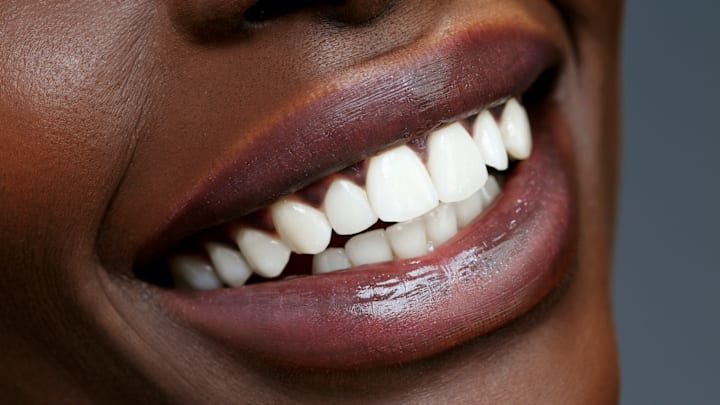The average adult human has 28 to 32 teeth, give or take a set of wisdom teeth. But besides the importance of brushing and flossing, how well do you know your chompers? From LED braces to pearly whites in hard-to-reach places, we bring you the tooth, the whole tooth, and nothing but the tooth.
1. Some babies are born with teeth.
About one in every 2000 babies is born with natal teeth, and their first dentist appointment is only a few days after birth. Natal teeth usually grow on the bottom gums and tend to have weak roots; they're often removed to prevent problems with breastfeeding and accidental swallowing. Being born with teeth can be a symptom of certain medical conditions, and ancient physiognomists associated it with evil—though it's usually harmless. Twin sister advice columnists Ann Landers and Abigail Van Buren were both born with teeth. So were Napoleon and Julius Caesar.
2. Not everyone loses their baby teeth.
Losing baby teeth is a rite of passage, not to mention a small source of income for most kids. By age 3, the average child has a full set of 20 temporary teeth. These little chiclets loosen and eventually fall out as the permanent teeth below start to erupt. Children typically start losing teeth around 5 or 6 and finish in their early teens. But if a person doesn't have a replacement permanent tooth, that baby tooth will stay put.
3. Some people lose teeth throughout their lives.
Mo' molars, mo' problems? Depends whom you ask. People with hyperdontia have extra, or super-numerary, teeth. Most of these teeth remain hidden below the gumline, but occasionally they'll erupt and crowd other teeth. If extra teeth crash a mouth party, a dentist can remove them, or an orthodontist can straighten all of them out with braces. Very rarely, a person will lose a "permanent" set of teeth at an older age, only to have another, hopefully more permanent set grow back in. The rest of us have to get dentures.
4. Tumors can grow teeth.
No one wants to deal with an abnormal growth, but teratomas are especially freaky. These rare germ cell tumors can contain several types of tissues and are usually found in the ovaries, testes, and near the tailbone. Some of them even contain teeth. And hair. And occasionally eyes or bones. Fortunately, many teratomas are benign and can be surgically removed. If you've got one, here's hoping the Tooth Fairy sends you a get-well card.
6. A tooth in your eye doesn't have to be a bad thing.
Ever hear the expression "I'd give my eye-teeth"? One woman literally gave her eye a tooth to restore her vision. Sharon Thornton had lost her vision to Stevens-Johnson syndrome, a condition that destroys the cells on the eye’s surface. In 2009, Thornton elected to try an unusual surgery. One of her canines was removed, so her cheek and dental tissue could be implanted in her left eye, replacing the damaged cornea. Within a day, she regained 20/70 vision and the hope of improved sight in the future.
7. Braces are cooler than ever before.
Back in ye olde days of orthodontia, the most creative thing the metal-mouthed could do with their braces was choose the color of their rubber bands. Today's options include Invisalign or lingual braces hidden along the inside of your teeth. Or you can modernize traditional braces with glow-in-the-dark or LED technology. In the former option, fluorescent rubber bands or brackets glow when light-activated. (Orthodontists suggest shining a flashlight on the braces for a quick demonstration.) The Japanese clothing store Laforet Harajuku invented LED braces for a January 2011 ad campaign. Switched on by smiling wide, these multicolored flashing lights don't actually straighten teeth. They will, however, make you the coolest kid at a rave.
8. Not all cultures consider straight teeth the beauty ideal.
Straight white teeth might seem universally appealing, but one country's snaggletooth is another country's sex appeal. In Japan, a fanged look called yaeba ("double tooth") is so admired that some women get crooked veneers to enhance their smiles. They figure that crowded chompers make them look younger and more adorable, which makes sense. American parents could save lots of money if the trend ever catches on here.
9. Humans will evolve past wisdom teeth.
A third set of molars helped our larger-jawed ancestors grind up roots, nuts, and leaves. But today, 35 percent of people are born without wisdom teeth. Most of the rest of us are encouraged to get ours removed—our mouths are too small; our dentistry too pricey to screw up. When our bodies no longer need an organ or part, it becomes vestigial and eventually disappears. According to scientists, future generations will lack appendices, wisdom teeth, and maybe even little toes.
10. Candy is better for your teeth than raisins.
Not all sweets are equally bad for your teeth. In fact, you might be surprised which treats are more likely to cause cavities. Sugar from all the foods we eat feeds bacteria that create acid and erode tooth enamel. With enough erosion over time, a tooth becomes the Grand Cavity Canyon. So how do you have your snacks and keep the teeth to eat them, too? Ditch foods that get stuck in your teeth (breads, chips, and fruit snacks) for those that dissolve quickly (chocolate, caramels, and jelly beans). It's also better to snack all at once than to munch and feed bacteria throughout the day.
A version of this story ran in 2012; it has been updated for 2022.
